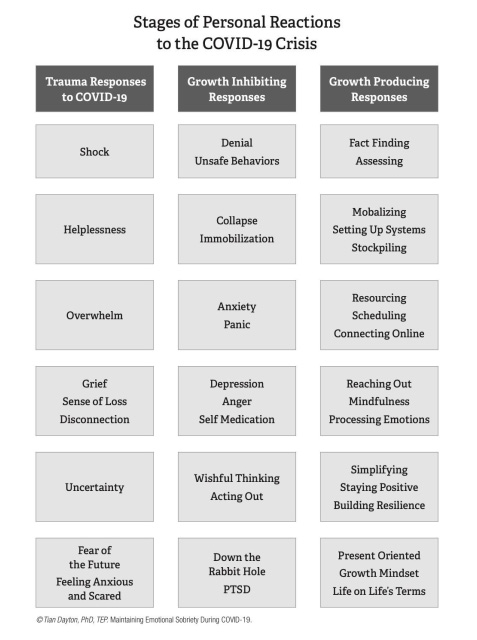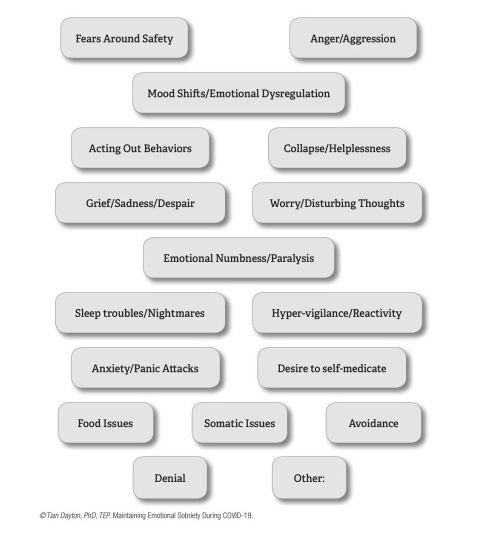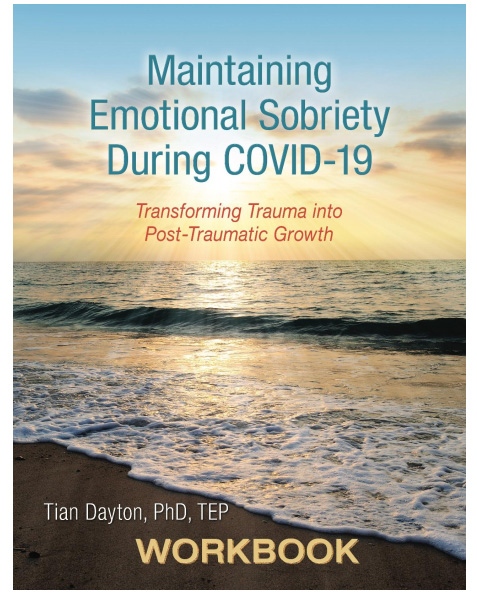
COVID-19 has hit us all, clients and therapists. It is one of those unique, historical moments, like 9/11, when we’re going through a similar experience as our clients. In the supervising that I am doing I hear a lot about emotional overload, feelings of uncertainty and zoom fatigue? So who’s taking care of the caregivers? Our hearts go out all the time to the first line workers who are being asked daily to face a deadly virus, initially without even having proper protection for themselves. They are truly the heroes of this pandemic. But there are second line workers, mental health workers, who are also experiencing what has come to be known as compassion fatigue, originally called vicarious traumatization. So we need to find ways as a field, to turn our attentions to caring for our workers and clients alike.
The mental health workers that I deal with are reposting some fairly consistent themes. On the subject of one-to-one therapy, “telehealth works”, “a lot of my clients love it”, “we’ve had some very intimate sessions”. And relative to group therapy online, “I have trouble keeping them engaged”, “I find group exhausting”, “it can work but I’s harder” are comments I hear a lot on this front.
Many experts including myself have been giving advice and I personally think that most of it has been very helpful in figuring out how to set up our lives and create a sense of personal safety during unsafe times. But what we need for the next layer of help, is a process. We need, therapists and clients alike to be able to somehow engage in our own personal healing. Mindfulness practices are key to this, learning how to keep the body and mind in an aware state with down-regulated stress response is invaluable to navigating these strange times. But there is another very important aspect of staying mentally well and that is to be able to identify what’s getting triggered in us personally be living in a situation of confinement and uncertainty, that is happening inside of us, what are our own personal manifestations, triggers and what can we do about them? The way that you manage and see these issues, will be a significant factor in whether or not they become traumatizing, the little things you do now, can make a big difference later. How you set up your life during COVID-19, will impact how it affects you now, and how it will impact you in the months to come.
We want to avoid these cumulative, pre-trauma symptoms being left unattended to, and morphing into post-traumatic stress issues later on. Maintaining Emotional Sobriety During COVID-19, contains the kind of information and work pages that help you to gain insight into which of these issues or feelings might be showing up for you. It gives you a user-friendly way to understand and process them so that you can transform feelings and thoughts that might otherwise undermine your feeling of well-being into post traumatic growth.
There is something called pre-trauma stress. “It’s a phenomenon,” writes Stacy Colino in US News and World Report, “you won’t find in the Diagnostic and Statistical Manual of Mental Disorders, (DSM-V). . . . The symptoms are similar to post-traumatic stress disorder (including grief, sadness, worry, disturbing intrusive thoughts, sleep troubles and nightmares, and avoiding situations or activities that are reminiscent of the stressful event) but in this case, they stem from anticipatory anxiety about an event that may occur in the future.” Parents can feel it on behalf of their children, “will they fall behind at school, will missing major life events wound them permanently, do they yearn for their friends, their life?” Or we can feel it on our own behalf, “when will I have my life back?
Take a look at the list of pre-trauma symptoms and see if you find any of these are manifesting for you.

Becoming Aware of Our Triggers: Separating the Past from the Present
To maintain self-regulation, you need to develop the ability to process rather than shut down feelings, to understand your inner world rather than push it away. Otherwise, when you get triggered, your hidden or unprocessed emotions will likely jettison to the surface and come out as blame, anger, negativity, sadness or even rage. And because they were never thought through to begin with, they will look for a target and that target is likely to be whatever triggered them. Then the wounds of the past get mixed up with this current stressor, and we have a real mess to sort through.
But as we develop the ability to tolerate and “sit with” what we are feeling so that we can become more mindful of what it is going on inside of us, we become a witness in our inner world. And we also want to develop what the Buddhists call self-compassion; we want to go easy on ourselves and in turn lighten up on others. Because if you enter this COVID-19 period with adverse childhood experiences, and have never delved down to understand how you got hurt and how feeling unseen and wounded affected you, you are likely to get triggered back into the wordlessness of early, childhood pain and you’ll feel at risk and alone, all over again.
Maintaining Your Emotional Sobriety
Emotional sobriety allows us to live in 4, 5 and 6 rather than to shoot from 0–10 and 10–0, with no speed bumps in between. It is about self-regulation.
A hallmark of trauma is living in emotional and psychological extremes.
Shooting from shut down to overwhelm and overwhelm back to shut down. Trauma invariably leads to a loss of self-regulation.
Self-regulation is a hallmark of emotional sobriety, so this workbook is about working with the parts of us that we have thrown out of conscious awareness either because we were terrified at the time something happened and so our capacity to think about it or “observe” what was happening was off line, because the prefrontal cortex was shut down.
When we’re terrified or highly stressed, our thinking mind shuts down while our limbic system, our fight/flight/freeze system, revs way up. Nature didn’t want us thinking about whether or not to run from a charging mammoth, she wanted us to flee for safety or to prepare for defending ourselves or to feign death until danger passed. That’s why this is called our survival system. Because the limbic system processes emotions, and sensory impressions like sights, sounds, smells and so forth, our body busily records our sense impressions during these moments of high stress, alongside the emotions we experienced. However, we made no overall meaning or interpretation of events, no story line. We remember the general outline and what we associate with these incidences but not the details. Because our thinking mind, our pre-frontal cortex shuts down, we lose some of our executive function, which means our ability to name, reflect on and regulate our emotions through understanding is compromised. So later, when something scares or stresses us again, the feelings of fear, vulnerability or anxiety can trigger these “frozen memories, these body memories” inside of us but our reasoning is missing unless we develop specific skills of mindfulness like learning to “pause” and “reflect.” And because the limbic system also processes bonding chemicals, when we’re traumatized it affects our relationships and our ability to trust and attach. Trauma can make us feel different, it’s de-personalizing so it can lead to isolating which can lead to depression and we don’t effectively use our relationships as part of our self-regulation. We feel depending maybe isn’t such a good idea. So when we get triggered, we self-protect, we slide into survival responses of fight, flight or freeze and we lose a sense of connection with the other person. This can become exacerbated in confinement, but it can also open a path towards healing. As human beings, we tend to avoid thinking about painful feelings. COVID-19 triggers those kinds of issues that we’re able to avoid in the busyness of our day to day lives. Using what gets triggered as an opportunity to heal can turn this loss into a gain. Accepting what gets triggered as a welcome window into our unconscious, can become a silver lining in terms of healing and recovery, it can open doors to our inner world that may normally be shut and allow light in.
Maintaining Emotional Sobriety During COVID-19 offers focused research based exercises for all of the range of issues that may arise throughout COVID days and gives a process to work through how these issues may be impacting you personally. It can be used in:
- One-one-therapy
- Group Therapy
- Zoom Groups
- At home
- Peer Support Groups
I have also made guided meditations and guided imageries a part of this process because they teach the skills of mindfulness, self-soothing and self-regulation You’ll find these and other free resources under COVID-19 Resources on tiandayton.com.

WATCH THE VIDEO BELOW:


